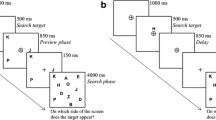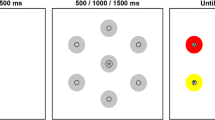Abstract
If some of the distractors in a visual search task are previewed prior to the presentation of the remaining distractors and the target, search time is reduced relative to when all of the items are displayed simultaneously. Here, we tested whether the ability to preferentially search new items during such a preview search is limited. We confirmed previous studies: The proportion of fixations on old items was significantly less than chance. However, the probability of fixating old locations was negatively affected by increasing the number of previewed distractors, suggesting that inhibition is limited to a small number of old items. Furthermore, the ability to inhibit old locations was limited to the first four fixations, indicating that by the fifth fixation, the resources required to sustain inhibition had been depleted. Together, these findings suggest that inhibition of old items in a preview search is a top-down mediated process dependent on capacity-limited cognitive resources.
Article PDF
Similar content being viewed by others
References
Braithwaite, J. J., Humphreys, G. W., & Hodsoll, J. (2003). Color grouping in space and time: Evidence from negative color-based carryover effects in preview search. Journal of Experimental Psychology: Human Perception & Performance, 29, 758–778.
Braithwaite, J. J., Humphreys, G. W., & Hulleman, J. (2005). Color-based grouping and inhibition in visual search: Evidence from a probe detection analysis of preview search. Perception & Psychophysics, 67, 81–101.
Carmi, R., & Itti, L. (2006). The role of memory in guiding attention during natural vision. Journal of Vision, 6, 898–914.
Cowan, N. (2001). The magical number 4 in short-term memory: A reconsideration of mental storage capacity. Behavioral & Brain Sciences, 24, 87–114.
Donk, M., & Theeuwes, J. (2001). Visual marking beside the mark: Prioritizing selection by abrupt onsets. Perception & Psychophysics, 63, 891–900.
Donk, M., & Theeuwes, J. (2003). Prioritizing selection of new elements: Bottom-up versus top-down control. Perception & Psychophysics, 65, 1231–1242.
Humphreys, G. W., Stalmann, B. J., & Olivers, C. (2004). An analysis of the time course of attention in preview search. Perception & Psychophysics, 66, 713–730.
Jiang, Y., Chun, M. M., & Marks, L. E. (2002). Visual marking: Dissociating effects of new and old set size. Journal of Experimental Psychology: Learning, Memory, & Cognition, 28, 293–302.
Jiang, Y., & Wang, S. W. (2004). What kind of memory supports visual marking? Journal of Experimental Psychology: Human Perception & Performance, 30, 79–91.
Luck, S. J., & Vogel, E. K. (1997). The capacity of visual working memory for features and conjunctions. Nature, 390, 279–281.
McCarley, J. S., Wang, R. F., Kramer, A. F., Irwin, D. E., & Peterson, M. S. (2003). How much memory does oculomotor search have? Psychological Science, 14, 422–426.
Posner, M. I., & Cohen, Y. (1984). Components of visual orienting. In H. Bouma & D. G. Bouwhuis (Eds.), Attention and performance Control of language processes (pp. 531–556). Hillsdale, NJ: Erlbaum.
Pratt, J., Theeuwes, J., & Donk, M. (2007). Offsets and prioritizing the selection of new elements in search displays: More evidence for attentional capture in the preview effect. Visual Cognition, 15, 133–148.
Watson, D. G., & Humphreys, G. W. (1997). Visual marking: Prioritizing selection for new objects by top-down attentional inhibition of old objects. Psychological Review, 104, 90–122.
Watson, D. G., & Inglis, M. (2007). Eye movements and time-based selection: Where do the eyes go in preview search? Psychonomic Bulletin & Review, 14, 852–857.
Zelinsky, G. J., & Sheinberg, D. L. (1997). Eye movements during parallel-serial visual search. Journal of Experimental Psychology: Human Perception & Performance, 23, 244–262.
Author information
Authors and Affiliations
Corresponding author
Additional information
This research was supported by NSERC grants to S.F. and J.P., NSERC scholarships to N.A. and S.M.E., and a CIHR grant awarded to S.F.
Note—Accepted by the editorial board of Editor-Elect Jeremy M. Wolfe.
Rights and permissions
About this article
Cite this article
Emrich, S.M., Ruppel, J.D.N., Al-Aidroos, N. et al. Out with the old: Inhibition of old items in a preview search is limited. Perception & Psychophysics 70, 1552–1557 (2008). https://doi.org/10.3758/PP.70.8.1552
Received:
Accepted:
Issue Date:
DOI: https://doi.org/10.3758/PP.70.8.1552




